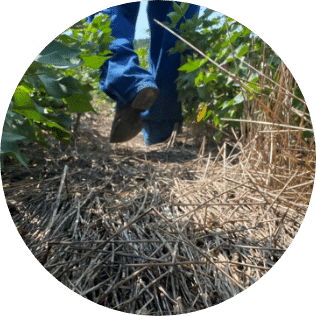

These include an effort to reduce greenhouse gas (GHG) emissions by 39% and increase soil carbon by 30% in the 10 years between 2015 and 2025 While these are aggressive goals, we think they are possible. In the U.S., cotton has seen a 25% reduction in greenhouse gas emissions since 1980.2 How? Cotton growers today use more efficient irrigation systems and use crop inputs more efficiently while increasing the amount of cotton produced per acre.

Making polyester fiber emits 3 times more greenhouse gases than cotton. Making nylon fiber takes nearly 5 times more greenhouse gases compared to cotton.3

If conservation tillage practices were adopted by just 20% of cotton growers globally, this shift alone would sequester 3.9 million tons of carbon per year in the soil – the same as taking more than 700,000 cars off the road for a year.4
Emissions
Emissions from cotton production are declining thanks to new technologies. The U.S. Cotton community has set goals to reduce GHG emissions by 39 percent by 2025, which is in line with the Paris Climate Agreement.

THE LATEST

The Fibers in Your Closet: Understanding Cellulose Biodegradability and the...
Learn how cotton breaks down in nature, why synthetic fibers don’t, and what this means for your wardrobe and the planet. Backed by new biodegradability data.
Agricultural Innovation: How Data is Cultivating a More Resilient Cotton...
Discover how data-driven innovation is transforming U.S. cotton farming—boosting efficiency, profitability, and sustainability from field to gin.
From the Ground Up: Grower Perspectives on Regenerative Agriculture
Regenerative agriculture adoption: U.S. cotton growers are embracing it for economic, community, and environmental wins. Tailored practices: Practices must adapt to diverse conditions across the 17 U.S. cotton-producing states. Long-term benefits: Focus on soil...
- U.S. Cotton Trust Protocol. (2021). Measures and verifies sustainability commitments. https://trustuscotton.org/about/powered-by-data/.
- Field to Market: The Alliance for Sustainable Agriculture, 2021. Environmental Outcomes from On-Farm Agricultural Production in the United States (Fourth Edition). ISBN: 978-0-578-33372-4. https://fieldtomarket.org/national-indicators-report/
- Moazzem, S., Crossin, E., Daver, F., & Wang, L. (2018). Baseline Scenario of Carbon Footprint of Polyester T-Shirt. Journal of Fiber Bioengineering and Informatics, 11(1), 1–14. http://journal10.magtechjournal.com/Jwk_JoFBaI/EN/Y2018/V11/I1/1.
- Cotton Incorporated (2021). Monthly Economic Letter: Cotton Market Fundamentals & Price Outlook, February 2021; Franzluebbers, A. J. (2010). Achieving Soil Organic Carbon Sequestration with Conservation Agricultural Systems in the Southeastern United States. Soil Science Society of America Journal, 74(2), 347–357. https://doi.org/10.2136/sssaj2009.0079.
- Causarano, H. J., A. J. Franzluebbers, D. W. Reeves, and J. N. Shaw. (2006). Soil Organic Carbon Sequestration in Cotton Production Systems of the Southeastern United States: A Review. J. Environ. Qual. 35:1374-1383.

